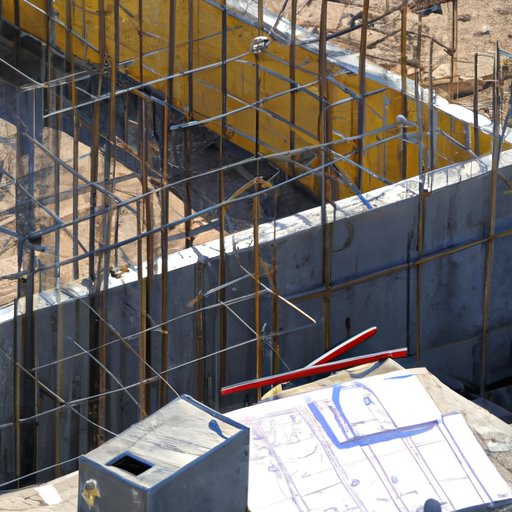
I. Introduction
Figuring concrete accurately can be a daunting task, especially for beginners. It requires thorough knowledge of calculation and accurate measurement. Misjudging the quantity of concrete necessary for a project can lead to financial loss, project delays and safety concerns. In this article, we will provide a comprehensive guide on how to figure concrete accurately, common mistakes to avoid, and tips from experts.
II. Step-by-step Guide on How to Figure Concrete
The following steps will guide you on how to figure concrete:
A. Materials required
Before you start figuring, ensure you have the necessary materials and tools. These include a calculator, measuring tape, spade, wheelbarrow and a pencil and paper to record your calculations.
B. Calculation of Concrete Volume
The next step in figuring concrete is calculating the volume required. The formula for calculating concrete volume is:
Volume = Length x Width x Depth
For instance, if your project area measures 20 feet by 10 feet and requires a depth of 4 inches, the volume calculation would be:
Volume = 20 x 10 x (4/12) feet
The result will give you the volume of concrete required in cubic feet. Ensure you convert the units to the same measurement to avoid confusion.
C. Expert tips to help facilitate the process
It’s advisable to round your volume calculation upwards, especially if you are unsure whether to over or under measure. Remember to factor in a 5-10% increase in the calculated volume to account for wastage, spillage, and settling of the concrete.
III. Tips to Figure Concrete Accurately
The following are some tips to help you figure concrete accurately:
A. Importance of measuring the area correctly
The most significant mistake beginners make is failing to measure the area correctly. Be sure to take accurate measurements, accounting for any obstructions, curves or irregularities in the area. Measure multiple times to avoid errors and ensure you record the exact measurements.
B. Double-checking calculations
It’s essential to double-check calculations to avoid errors. Check and recheck your volume calculations and measurements before you start mixing the concrete.
C. Other expert tips
Ensure you follow the correct mixing ratios and use the appropriate amount of water as specified on the packaging. Avoid mixing more concrete than you need to avoid wastage. Also, cover the mixed concrete with a tarp or plastic sheet to avoid drying out and to keep it moist.
IV. Common Mistakes to Avoid When Figuring Concrete
Some of the common mistakes to avoid when figuring concrete include:
A. Not accounting for irregular shapes
Irregular shapes can be particularly tricky to measure correctly and can lead to underestimating the concrete volume required. Be sure to measure carefully around the curves and corners of the shape.
B. Imprecise measurements
Imprecise measurements can lead to inaccurate calculations. Make sure you have the correct measurement tools and take the measurements as accurately as possible.
C. Other common errors
Errors in the mixing process such as not following the recommended ratio, adding too much water, or mixing in the wrong order can be costly mistakes.
V. DIY Guide to Figuring Concrete for Beginners
For beginners, understanding how to figure concrete can be overwhelming. Here is a step-by-step guide coupled with clear illustrations and diagrams:
A. Detailed explanations of each step
This article is dedicated to demystifying the process of figuring concrete, making it easy to understand each step.
VI. Concrete Cost Calculator
A. Introduction and explanation of the tool
In addition to figuring the volume of concrete, it’s essential to understand the cost implications. With a concrete cost calculator, you’ll have accurate estimates of how much concrete your project will consume. It’s an easy-to-use tool that can help save time and energy.
B. Variables used in calculating the cost
The variables used in calculating the cost of concrete include, but are not limited to, the size of the project, depth, type of concrete, and location. The calculator will give you an accurate estimate of how much you will spend on the project.
VII. Importance of Figuring Concrete Correctly
Concrete is a vital component in building and construction projects. As such, it’s crucial to figure concrete accurately to avoid the following issues:
A. Impact of incorrect measurements on the outcome of a project
Mis-calculating concrete volume can lead to an insufficient amount to complete your project. On the other hand, overestimating the volume may result in excess concrete that goes to waste, adding more expenses to the project.
B. Financial consequences
Incorrectly figuring concrete can have a significant financial impact on the project. It often leads to project overruns, delays, and additional costs due to repouring of concrete or material wastage.
C. Safety considerations
Incorrectly calculated concrete volume can also pose a safety risk to the building or the workers. It may compromise the structural integrity of the project and lead to accidents.
VIII. Conclusion
Figuring concrete is an essential part of construction projects and requires attention to detail. Accurate measurements and calculation ensure projects are completed on time and within budget. In this comprehensive guide, we have explained how to figure concrete, common mistakes to avoid, tips from experts, and the importance of getting the figures right. We hope this guide helps in your next project.
A. Recap of the key points
Figuring concrete accurately requires taking precise measurements, calculating the volume required, following the recommended mixing ratios and using the appropriate tools. It’s essential to double-check calculations to avoid mistakes.
B. Call to action
If you are planning a project, ensure you get accurate figures by following the steps outlined in this guide.
C. Final thoughts
Remember to always factor in a 5-10% increase in the calculated volume to account for wastage, spillage, and settling concrete. Following these tips and instructions will ensure a successful project and save you valuable time and resources.




